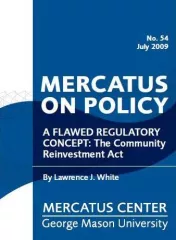- | Regulation Regulation
- | Policy Briefs Policy Briefs
- |
Blueprint for Regulatory Reform: First, Lay the Cornerstone
The United States’ regulatory system long has failed to consistently produce efficient, cost-effective regulations that deliver promised benefits. For decades, presidents and Congresses have attempted to fix the regulatory system through a series of statutes and executive orders aimed at increasing transparency and improving analysis. Yet the pattern of poor regulatory choices persists, suggesting the problems are not political but deeply embedded in the institutions themselves.
The United States’ regulatory system long has failed to consistently produce efficient, cost-effective regulations that deliver promised benefits. For decades, presidents and Congresses have attempted to fix the regulatory system through a series of statutes and executive orders aimed at increasing transparency and improving analysis. Yet the pattern of poor regulatory choices persists, suggesting the problems are not political but deeply embedded in the institutions themselves.
Faced with some of the toughest economic challenges in generations, Congress is taking a closer look at the balance between the burdens and benefits of regulation and what reforms could embed the principles of good regulatory decision making.
To aid in that effort, a new study by the Mercatus Center’s Richard Williams and Sherzod Abdukadirov reviews key problems in the regulatory process, weighs the pros and cons of leading reform proposals, and identifies the first steps on the path toward successful comprehensive reform. Below is a brief summary; to read “A Blueprint for Regulatory Reform” in its entirety and learn more about the authors, please click here.
KEY REFORMS
Apply Same Analysis Standards to Executive Branch and Independent Agencies. At present, executive orders requiring federal regulatory analysis do not apply to independent agencies. As a result, independent agencies are not subject to the same standards as executive branch agencies. To better serve the public interest, Congress should ensure all agencies are subject to the same requirements for regulatory analysis, including review by the Office of Information and Regulatory Affairs.
Require Regulatory Impact Analysis by Statute. Agencies should perform proper analysis on potential regulations, but they frequently fail to meet long-standing quality standards. Too often, agencies misuse analysis as a means to justify pre-determined decisions rather than as a tool to inform decision making. To foster better analysis, Congress should mandate regulatory analysis by statute. This will ensure all stakeholders have the right to challenge—and to expose—poor regulatory decisions.
Require Congressional Approval of Major Regulations. To provide a clear path of accountability for results, Congress should review and vote on major regulations derived from the statues they pass.


